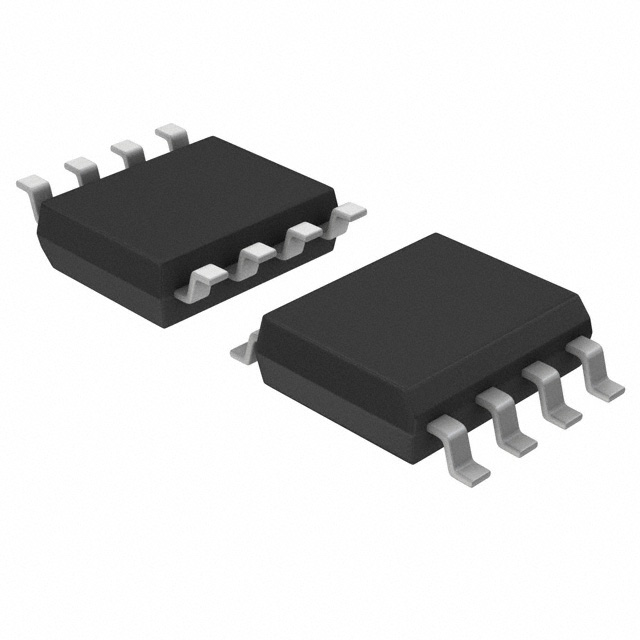Consulte las especificaciones para obtener detalles del producto.

AT45DB041E-SHNHT-T
Product Overview
- Category: Integrated Circuit (IC)
- Use: Data Flash Memory
- Characteristics: High-density, Serial Interface, Low Power Consumption
- Package: 8-Lead SOIC, 8-Lead TSSOP
- Essence: Non-volatile memory for storing data in electronic devices
- Packaging/Quantity: Tape and Reel, 2500 units per reel
Specifications
- Memory Size: 4 Megabits (512 Kbytes)
- Interface: Serial Peripheral Interface (SPI)
- Operating Voltage: 2.7V to 3.6V
- Operating Temperature: -40°C to +85°C
- Data Retention: 20 years
- Page Size: 264 bytes
- Sector Size: 256 pages
- Write Endurance: 10,000 write cycles per sector
Pin Configuration
The AT45DB041E-SHNHT-T has the following pin configuration:
- Chip Select (/CS)
- Output Enable (/OE)
- Serial Clock (SCK)
- Serial Data Input (SI)
- Serial Data Output (SO)
- Write Protect (/WP)
- Reset (/RESET)
- VCC (Power Supply)
Functional Features
- High-speed data transfer using SPI interface
- Sector-based erase and program operations
- Continuous read mode for efficient data retrieval
- Software and hardware protection mechanisms
- Low power consumption during standby and active modes
- Automatic page write and erase algorithms
Advantages and Disadvantages
Advantages: - High-density memory storage - Fast data transfer rate - Low power consumption - Long data retention period - Flexible sector-based operations
Disadvantages: - Limited write endurance per sector - Relatively small page size
Working Principles
The AT45DB041E-SHNHT-T is based on the Serial Peripheral Interface (SPI) protocol. It utilizes a combination of floating gate and tunnel oxide technology to store data in non-volatile memory cells. The memory is organized into sectors, with each sector consisting of multiple pages. Data can be written, read, and erased at the sector level, providing flexibility for various applications.
During operation, the chip select pin (/CS) is used to enable communication with the device. The serial clock (SCK) synchronizes data transfer between the microcontroller and the memory. The serial data input (SI) pin is used to send commands and data to the memory, while the serial data output (SO) pin transmits data from the memory to the microcontroller.
Detailed Application Field Plans
The AT45DB041E-SHNHT-T is widely used in various electronic devices that require non-volatile memory storage. Some common application fields include:
- Consumer Electronics: Used in digital cameras, MP3 players, and portable gaming devices for storing user data, firmware, and configuration settings.
- Industrial Automation: Employed in programmable logic controllers (PLCs), sensors, and control systems to store critical data and program code.
- Automotive: Integrated into automotive electronics for storing vehicle parameters, infotainment system data, and firmware updates.
- Medical Devices: Utilized in medical equipment for storing patient data, device configurations, and software updates.
- Internet of Things (IoT): Incorporated into IoT devices for data logging, sensor readings, and firmware upgrades.
Detailed and Complete Alternative Models
- AT45DB081E-SHNHT-T: 8 Megabit (1 Mbyte) version of the same flash memory IC.
- AT45DB161E-SHNHT-T: 16 Megabit (2 Mbyte) version with similar features.
- AT45DB321E-SHNHT-T: 32 Megabit (4 Mbyte) variant offering increased storage capacity.
- AT45DB641E-SHNHT-T: 64 Megabit (8 Mbyte) model for applications requiring larger memory size.
These alternative models provide options for higher memory capacities while maintaining compatibility and similar functionality to the AT45DB041E-SHNHT-T.
Word count: 457 words
Enumere 10 preguntas y respuestas comunes relacionadas con la aplicación de AT45DB041E-SHNHT-T en soluciones técnicas
Sure! Here are 10 common questions and answers related to the application of AT45DB041E-SHNHT-T in technical solutions:
Q: What is the AT45DB041E-SHNHT-T? A: The AT45DB041E-SHNHT-T is a serial flash memory device manufactured by Adesto Technologies. It offers 4 megabits (512 kilobytes) of storage capacity.
Q: What is the interface used to communicate with the AT45DB041E-SHNHT-T? A: The AT45DB041E-SHNHT-T uses a standard SPI (Serial Peripheral Interface) for communication with microcontrollers or other devices.
Q: What voltage levels does the AT45DB041E-SHNHT-T support? A: The AT45DB041E-SHNHT-T supports a wide range of voltage levels, from 2.7V to 3.6V.
Q: Can I use the AT45DB041E-SHNHT-T in battery-powered applications? A: Yes, the low power consumption of the AT45DB041E-SHNHT-T makes it suitable for battery-powered applications.
Q: How fast can data be read from the AT45DB041E-SHNHT-T? A: The AT45DB041E-SHNHT-T has a maximum data transfer rate of 66 MHz, allowing for fast read operations.
Q: Is the AT45DB041E-SHNHT-T capable of performing write operations? A: Yes, the AT45DB041E-SHNHT-T supports both sequential and random write operations.
Q: Can the AT45DB041E-SHNHT-T be used as a storage device for firmware updates? A: Absolutely! The AT45DB041E-SHNHT-T is commonly used for storing firmware updates in various embedded systems.
Q: Does the AT45DB041E-SHNHT-T have any built-in security features? A: Yes, the AT45DB041E-SHNHT-T offers several security features, including software and hardware protection mechanisms.
Q: Can I use multiple AT45DB041E-SHNHT-T devices in parallel to increase storage capacity? A: Yes, the AT45DB041E-SHNHT-T supports daisy-chaining, allowing you to connect multiple devices together for increased storage capacity.
Q: Are there any development tools or libraries available for working with the AT45DB041E-SHNHT-T? A: Yes, Adesto Technologies provides a range of development tools, including software libraries and evaluation boards, to facilitate the integration of the AT45DB041E-SHNHT-T into your technical solutions.
Please note that these answers are general and may vary depending on specific application requirements and implementation details.

